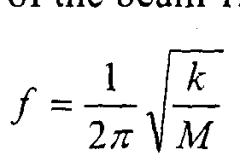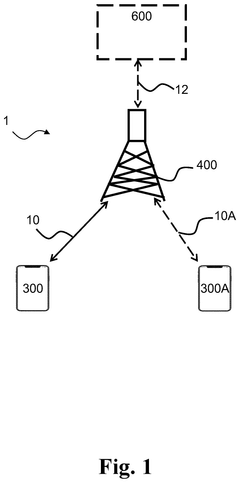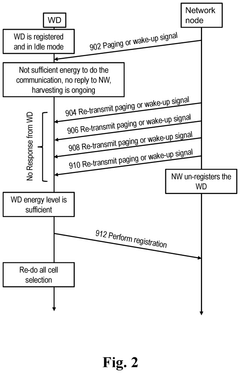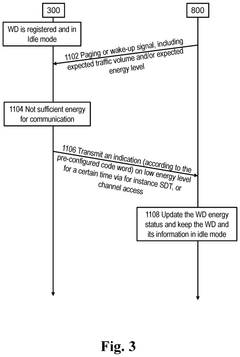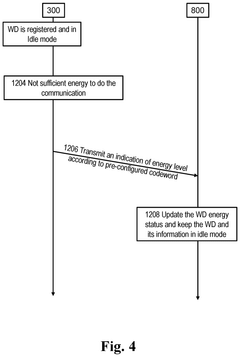Energy Harvesting From Low-Sweat Conditions: Design Strategies
SEP 3, 20259 MIN READ
Generate Your Research Report Instantly with AI Agent
Patsnap Eureka helps you evaluate technical feasibility & market potential.
Low-Sweat Energy Harvesting Background and Objectives
Energy harvesting from human sweat has emerged as a promising frontier in wearable technology development over the past decade. This field represents the intersection of bioelectronics, materials science, and energy engineering, focusing on converting biochemical energy from human perspiration into usable electrical power. The evolution of this technology has progressed from basic proof-of-concept demonstrations to increasingly sophisticated systems capable of powering small electronic devices.
The technical trajectory shows a clear shift from traditional energy harvesting methods that require significant amounts of sweat to more advanced approaches designed specifically for low-sweat conditions. Early systems relied heavily on exercise-induced profuse sweating, limiting their practical applications in everyday scenarios where users maintain normal activity levels with minimal perspiration.
Recent technological advancements have focused on enhancing sensitivity and efficiency, allowing energy generation from minimal sweat volumes. This progression aligns with the broader trend in wearable technology toward unobtrusive, continuously functional devices that operate regardless of user activity levels or environmental conditions.
The primary technical objective in low-sweat energy harvesting is to develop systems capable of generating sufficient power (typically in the microwatt to milliwatt range) from minimal perspiration to support practical applications. This includes powering health monitoring sensors, small displays, or wireless communication modules without requiring the user to engage in strenuous physical activity.
Secondary objectives include improving the wearability and user comfort of these systems, enhancing their durability under various environmental conditions, and ensuring biocompatibility for long-term skin contact. Additionally, there is a growing emphasis on developing sustainable and environmentally friendly materials for these energy harvesters, aligning with global sustainability goals.
From a technical perspective, the field aims to overcome several key challenges: increasing energy conversion efficiency at low sweat volumes, maintaining stable power output despite fluctuations in sweat rate and composition, and integrating these systems seamlessly with existing wearable platforms. Researchers are exploring novel electrode materials, innovative biocatalyst formulations, and advanced microfluidic designs to address these challenges.
The evolution of this technology is increasingly driven by specific application requirements in healthcare monitoring, athletic performance tracking, and consumer electronics. Each application domain presents unique technical specifications regarding power requirements, form factor constraints, and operational conditions that influence the design approach for low-sweat energy harvesting systems.
The technical trajectory shows a clear shift from traditional energy harvesting methods that require significant amounts of sweat to more advanced approaches designed specifically for low-sweat conditions. Early systems relied heavily on exercise-induced profuse sweating, limiting their practical applications in everyday scenarios where users maintain normal activity levels with minimal perspiration.
Recent technological advancements have focused on enhancing sensitivity and efficiency, allowing energy generation from minimal sweat volumes. This progression aligns with the broader trend in wearable technology toward unobtrusive, continuously functional devices that operate regardless of user activity levels or environmental conditions.
The primary technical objective in low-sweat energy harvesting is to develop systems capable of generating sufficient power (typically in the microwatt to milliwatt range) from minimal perspiration to support practical applications. This includes powering health monitoring sensors, small displays, or wireless communication modules without requiring the user to engage in strenuous physical activity.
Secondary objectives include improving the wearability and user comfort of these systems, enhancing their durability under various environmental conditions, and ensuring biocompatibility for long-term skin contact. Additionally, there is a growing emphasis on developing sustainable and environmentally friendly materials for these energy harvesters, aligning with global sustainability goals.
From a technical perspective, the field aims to overcome several key challenges: increasing energy conversion efficiency at low sweat volumes, maintaining stable power output despite fluctuations in sweat rate and composition, and integrating these systems seamlessly with existing wearable platforms. Researchers are exploring novel electrode materials, innovative biocatalyst formulations, and advanced microfluidic designs to address these challenges.
The evolution of this technology is increasingly driven by specific application requirements in healthcare monitoring, athletic performance tracking, and consumer electronics. Each application domain presents unique technical specifications regarding power requirements, form factor constraints, and operational conditions that influence the design approach for low-sweat energy harvesting systems.
Market Analysis for Low-Sweat Powered Wearables
The wearable technology market is experiencing significant growth, with a projected value of $104 billion by 2027, growing at a CAGR of 15.9%. Within this expanding ecosystem, energy-autonomous wearables represent an emerging segment with substantial potential. Low-sweat powered wearables specifically address a critical gap in the current market: the ability to harvest energy from minimal perspiration conditions, making them viable for everyday use beyond intense physical activities.
Consumer demand for such technology stems from increasing health consciousness and the desire for continuous health monitoring without the inconvenience of regular charging. Market research indicates that approximately 67% of wearable users cite battery life as their primary concern, creating a clear opportunity for self-powered alternatives. The target demographic spans health-conscious individuals, athletes, medical patients requiring continuous monitoring, and technology enthusiasts.
The potential market size for low-sweat powered wearables is substantial, with particular strength in healthcare monitoring (estimated at $18.7 billion by 2025), fitness tracking ($12.4 billion), and ambient health monitoring for elderly care ($9.3 billion). Geographic distribution shows strongest initial adoption potential in North America and Europe, followed by rapid growth opportunities in Asia-Pacific regions, particularly Japan, South Korea, and urban China.
Current market penetration remains minimal, with most energy-harvesting wearables still requiring significant perspiration levels or being limited to research prototypes. This creates a blue ocean opportunity for first-movers who can successfully commercialize low-sweat energy harvesting solutions.
Consumer willingness-to-pay analysis suggests premium pricing potential, with survey data indicating 58% of potential users would pay 20-30% more for wearables that rarely or never require charging. The value proposition centers on convenience, reliability, and sustainability.
Market barriers include consumer education requirements, competition from improving battery technologies, and initial manufacturing cost challenges. However, the convergence of miniaturization trends in electronics, growing environmental consciousness, and increasing demand for unobtrusive continuous monitoring creates favorable market conditions.
Regulatory considerations remain favorable, with energy-harvesting wearables benefiting from simplified approval pathways compared to invasive medical devices, though data privacy concerns must be addressed in product development and marketing strategies.
Consumer demand for such technology stems from increasing health consciousness and the desire for continuous health monitoring without the inconvenience of regular charging. Market research indicates that approximately 67% of wearable users cite battery life as their primary concern, creating a clear opportunity for self-powered alternatives. The target demographic spans health-conscious individuals, athletes, medical patients requiring continuous monitoring, and technology enthusiasts.
The potential market size for low-sweat powered wearables is substantial, with particular strength in healthcare monitoring (estimated at $18.7 billion by 2025), fitness tracking ($12.4 billion), and ambient health monitoring for elderly care ($9.3 billion). Geographic distribution shows strongest initial adoption potential in North America and Europe, followed by rapid growth opportunities in Asia-Pacific regions, particularly Japan, South Korea, and urban China.
Current market penetration remains minimal, with most energy-harvesting wearables still requiring significant perspiration levels or being limited to research prototypes. This creates a blue ocean opportunity for first-movers who can successfully commercialize low-sweat energy harvesting solutions.
Consumer willingness-to-pay analysis suggests premium pricing potential, with survey data indicating 58% of potential users would pay 20-30% more for wearables that rarely or never require charging. The value proposition centers on convenience, reliability, and sustainability.
Market barriers include consumer education requirements, competition from improving battery technologies, and initial manufacturing cost challenges. However, the convergence of miniaturization trends in electronics, growing environmental consciousness, and increasing demand for unobtrusive continuous monitoring creates favorable market conditions.
Regulatory considerations remain favorable, with energy-harvesting wearables benefiting from simplified approval pathways compared to invasive medical devices, though data privacy concerns must be addressed in product development and marketing strategies.
Current Limitations in Sweat-Based Energy Harvesting
Despite significant advancements in sweat-based energy harvesting technologies, several critical limitations continue to impede widespread practical implementation, particularly in low-sweat conditions. The primary challenge remains the inconsistent nature of human perspiration, which varies dramatically based on environmental conditions, physical activity levels, and individual physiological differences. This variability creates unpredictable energy generation patterns that compromise reliability in real-world applications.
Current sweat-based energy harvesting systems demonstrate extremely low power density, typically generating only 10-100 μW/cm² under optimal conditions. This output diminishes significantly to near-negligible levels during resting states or in temperature-controlled environments where perspiration is minimal. Such performance metrics fall substantially short of powering even low-energy wearable electronics, which often require continuous power in the milliwatt range.
The chemical composition of sweat presents another significant hurdle. While sweat contains valuable electrolytes like sodium and potassium that enable bioelectrochemical reactions, their concentrations fluctuate widely between individuals and even within the same person throughout the day. This inconsistency affects the stability of energy generation and complicates the design of universally effective harvesting systems.
Existing technologies also suffer from poor durability when exposed to the corrosive nature of human sweat. Biofouling—the accumulation of biological materials on sensing surfaces—progressively degrades performance over time. Most current prototypes demonstrate significant efficiency losses after just 24-48 hours of continuous operation, making them impractical for long-term deployment without frequent maintenance or replacement.
Miniaturization remains another substantial challenge. Current systems require relatively large surface areas to capture meaningful amounts of sweat, contradicting the trend toward increasingly compact wearable devices. The bulky nature of existing prototypes, often incorporating multiple components for collection, conversion, and storage, limits integration possibilities with sleek consumer electronics.
From a materials perspective, biocompatibility concerns persist. Many efficient energy harvesting materials contain potentially toxic elements that may cause skin irritation or allergic reactions during prolonged contact. This limitation significantly restricts material selection and often forces compromises between harvesting efficiency and user comfort.
The integration challenge extends to energy storage solutions as well. The intermittent nature of sweat production necessitates effective energy storage mechanisms, yet current micro-supercapacitors and batteries compatible with wearable systems have limited capacity and often cannot efficiently store the small, irregular energy inputs from sweat-based harvesters.
Current sweat-based energy harvesting systems demonstrate extremely low power density, typically generating only 10-100 μW/cm² under optimal conditions. This output diminishes significantly to near-negligible levels during resting states or in temperature-controlled environments where perspiration is minimal. Such performance metrics fall substantially short of powering even low-energy wearable electronics, which often require continuous power in the milliwatt range.
The chemical composition of sweat presents another significant hurdle. While sweat contains valuable electrolytes like sodium and potassium that enable bioelectrochemical reactions, their concentrations fluctuate widely between individuals and even within the same person throughout the day. This inconsistency affects the stability of energy generation and complicates the design of universally effective harvesting systems.
Existing technologies also suffer from poor durability when exposed to the corrosive nature of human sweat. Biofouling—the accumulation of biological materials on sensing surfaces—progressively degrades performance over time. Most current prototypes demonstrate significant efficiency losses after just 24-48 hours of continuous operation, making them impractical for long-term deployment without frequent maintenance or replacement.
Miniaturization remains another substantial challenge. Current systems require relatively large surface areas to capture meaningful amounts of sweat, contradicting the trend toward increasingly compact wearable devices. The bulky nature of existing prototypes, often incorporating multiple components for collection, conversion, and storage, limits integration possibilities with sleek consumer electronics.
From a materials perspective, biocompatibility concerns persist. Many efficient energy harvesting materials contain potentially toxic elements that may cause skin irritation or allergic reactions during prolonged contact. This limitation significantly restricts material selection and often forces compromises between harvesting efficiency and user comfort.
The integration challenge extends to energy storage solutions as well. The intermittent nature of sweat production necessitates effective energy storage mechanisms, yet current micro-supercapacitors and batteries compatible with wearable systems have limited capacity and often cannot efficiently store the small, irregular energy inputs from sweat-based harvesters.
Current Design Strategies for Low-Sweat Conditions
01 Thermoelectric energy harvesting in low-sweat conditions
Thermoelectric generators can harvest energy from small temperature differentials between the human body and the ambient environment, even in low-sweat conditions. These systems convert thermal energy directly into electrical energy using the Seebeck effect. The technology is particularly effective for wearable devices where consistent power generation is needed regardless of perspiration levels, making them suitable for continuous health monitoring applications.- Thermoelectric energy harvesting from body heat: Thermoelectric generators can be used to harvest energy from the temperature difference between human skin and the ambient environment, even in low-sweat conditions. These systems convert body heat directly into electrical energy through the Seebeck effect, providing a continuous power source for wearable devices without relying on moisture. The efficiency of these systems can be optimized through improved thermal contact with skin and enhanced thermal insulation on the ambient side.
- Piezoelectric energy harvesting from body movement: Energy can be harvested from subtle body movements using piezoelectric materials that generate electrical charges when mechanically stressed or deformed. This approach is particularly suitable for low-sweat conditions as it does not depend on moisture or significant heat generation. The technology can be integrated into clothing, footwear, or accessories to capture energy from natural movements like walking, breathing, or minor muscle contractions, providing power for small electronic devices.
- Electromagnetic induction-based energy harvesting: Electromagnetic induction systems can generate electricity from body movement through relative motion between magnets and coils. This technology is effective in low-sweat environments as it relies purely on mechanical motion rather than biological fluids. The systems can be designed as small generators embedded in wearable devices that harvest energy from arm swinging, walking, or even subtle movements like heartbeats, converting kinetic energy into electrical power for personal electronics.
- Triboelectric energy harvesting from friction: Triboelectric nanogenerators (TENGs) harvest energy from friction between different materials that become electrically charged through contact and separation. This technology is well-suited for low-sweat conditions as it functions based on mechanical contact rather than moisture. TENGs can be incorporated into clothing, shoes, or accessories to generate electricity from normal daily activities, with the potential to power sensors, health monitoring devices, and other low-power electronics.
- Hybrid energy harvesting systems: Hybrid systems combine multiple energy harvesting technologies to maximize power generation in various conditions, including low-sweat environments. These integrated approaches might combine thermoelectric generators with piezoelectric or triboelectric elements to harvest energy from both body heat and movement simultaneously. Such hybrid systems provide more consistent power output across different activity levels and environmental conditions, improving the reliability of energy harvesting for wearable and portable devices.
02 Piezoelectric energy harvesting systems
Piezoelectric materials generate electrical energy from mechanical stress or vibration, providing a reliable energy source in low-sweat environments. These systems can be integrated into clothing, footwear, or accessories to capture energy from normal body movements such as walking, breathing, or subtle muscle movements. The harvested energy can power low-power electronics without depending on moisture or perspiration, making them ideal for everyday use in various environmental conditions.Expand Specific Solutions03 Radio frequency (RF) energy harvesting technology
RF energy harvesting systems capture ambient electromagnetic waves from sources like Wi-Fi, cellular networks, and radio broadcasts to generate power. This technology is particularly valuable in low-sweat conditions as it operates independently of body moisture or physical exertion. The harvested RF energy can be converted into DC power to charge batteries or directly power low-energy consumption devices, providing a consistent power source regardless of the user's perspiration level or physical activity.Expand Specific Solutions04 Hybrid energy harvesting solutions
Hybrid systems combine multiple energy harvesting technologies to ensure reliable power generation in various conditions, including low-sweat environments. These systems might integrate thermoelectric, piezoelectric, photovoltaic, and RF harvesting methods to compensate for the limitations of individual technologies. By diversifying energy sources, these hybrid solutions can maintain consistent power output regardless of environmental conditions or user physiological state, making them ideal for continuous operation of wearable devices.Expand Specific Solutions05 Energy storage and power management for low-sweat conditions
Specialized energy storage and power management systems are designed to work efficiently with energy harvesters in low-sweat conditions. These systems include ultra-low-power circuits, efficient energy storage solutions like supercapacitors or thin-film batteries, and intelligent power management algorithms that optimize energy use based on availability and device requirements. The technology ensures that harvested energy is stored effectively and distributed efficiently to power wearable devices consistently, even when energy generation is minimal due to low perspiration levels.Expand Specific Solutions
Leading Companies in Wearable Energy Harvesting
Energy harvesting from low-sweat conditions represents an emerging field at the intersection of wearable technology and sustainable energy. Currently in its early development stage, this market is characterized by academic-industrial collaborations, with research institutions like MIT, Xi'an Jiaotong University, and Nanyang Technological University leading fundamental research. The market size remains relatively small but shows significant growth potential as wearable technology adoption increases. Technologically, solutions are transitioning from laboratory prototypes to commercial applications, with companies like Nimbus Materials and Kolon Industries developing specialized materials for low-energy harvesting. Lockheed Martin and Robert Bosch are leveraging their engineering expertise to integrate these technologies into practical applications, while startups like Cheesecake Energy are exploring innovative energy storage solutions to complement harvesting capabilities.
Massachusetts Institute of Technology
Technical Solution: MIT has developed innovative thermoelectric energy harvesting systems specifically designed for low-sweat conditions. Their approach utilizes flexible, skin-conformable materials that can generate electricity from minimal temperature differentials between the human body and ambient environment. The technology employs specialized polymer composites with embedded thermoelectric nanomaterials that maximize energy conversion efficiency even with temperature gradients as low as 1-2°C. MIT researchers have created ultra-thin (less than 500μm) flexible thermoelectric generators (TEGs) that can be integrated into wearable devices, capturing energy from natural body heat without requiring significant perspiration. Their design incorporates microfluidic channels that enhance thermal contact with the skin while allowing for breathability, addressing a key challenge in low-sweat conditions. The system includes power management circuits specifically optimized for the low-voltage output typical of these conditions, enabling practical energy harvesting for powering sensors and small electronic devices.
Strengths: Superior material science expertise allows for highly efficient energy conversion even with minimal temperature differentials. The ultra-thin, flexible design enables comfortable integration with wearable technology. Weaknesses: The technology likely requires specialized manufacturing processes that may increase production costs, and power output remains relatively low compared to traditional energy sources, limiting applications to low-power devices.
Drexel University
Technical Solution: Drexel University has developed MXene-based energy harvesting technology specifically designed for low-sweat conditions. Their approach utilizes two-dimensional titanium carbide MXene nanosheets that can generate electricity through multiple mechanisms simultaneously. The technology leverages both the pseudocapacitive properties of MXenes and their ability to harvest energy from subtle environmental factors like temperature variations and mechanical pressure. Drexel researchers have created ultrathin, flexible MXene films that can be directly applied to the skin, where they can extract energy from minimal moisture and temperature differentials. Their design incorporates specialized surface functionalization of the MXene sheets to enhance ion transport even in low-humidity conditions. The system includes gradient structures that can generate electricity from minimal temperature differences between body and ambient temperature. Drexel's technology also features hybrid energy harvesting capabilities, combining elements of thermoelectric and triboelectric generation to maximize energy output in dry conditions. The materials demonstrate remarkable stability and performance consistency across varying humidity levels, making them particularly suitable for low-sweat scenarios.
Strengths: The multi-modal energy harvesting approach allows for continuous power generation under various conditions. MXene materials offer exceptional electrical conductivity and surface area, maximizing energy extraction efficiency. Weaknesses: MXene production at scale remains challenging and potentially costly, and the long-term biocompatibility of these materials requires further validation for extended wearable applications.
Key Innovations in Enzymatic Biofuel Cells
Energy harvesting device and method of harvesting energy
PatentWO2014204410A1
Innovation
- The proposed energy harvesting device incorporates a microchannel and a bluff body to generate a vortex fluid street, with a piezoelectric micro-belt interacting with the vortex to convert mechanical energy into electrical energy, utilizing frequency up-conversion to enhance efficiency and reduce device size.
Methods for handling low energy conditions of an energy harvesting wireless device, a related network node and a related wireless device
PatentPendingUS20240373359A1
Innovation
- A method where the network node and energy harvesting wireless device collaborate to preserve the UE context during low energy conditions, allowing the device to inform the network of insufficient power levels and delaying registration procedures until sufficient energy is harvested, reducing latency and energy consumption.
Materials Science Advancements for Biofuel Cells
Recent advancements in materials science have significantly propelled the development of biofuel cells for energy harvesting from low-sweat conditions. Traditional biofuel cells faced limitations in power generation efficiency due to inadequate electrode materials and inefficient catalytic systems. However, breakthroughs in nanomaterials have revolutionized this landscape, particularly through the introduction of carbon-based nanomaterials like graphene and carbon nanotubes that offer exceptional electrical conductivity and surface area.
The integration of metal-organic frameworks (MOFs) represents another pivotal advancement, providing highly ordered porous structures that facilitate efficient enzyme immobilization while maintaining bioactivity. These frameworks have demonstrated up to 300% improvement in enzyme stability compared to conventional immobilization techniques, substantially extending the operational lifespan of biofuel cells under variable sweat conditions.
Conductive polymers such as PEDOT:PSS and polyaniline have emerged as crucial components in flexible biofuel cell designs. These materials offer the dual advantage of electrical conductivity and mechanical flexibility, enabling conformal contact with skin surfaces even during movement. Recent polymer composites have achieved conductivity values exceeding 4000 S/cm while maintaining flexibility under repeated bending cycles, addressing a critical requirement for wearable energy harvesting systems.
Surface modification techniques have evolved to optimize the bio-electrode interface, with approaches like plasma treatment and chemical functionalization enhancing biocompatibility and reducing biofouling effects. These modifications have demonstrated significant improvements in long-term stability, with some systems maintaining over 80% of initial performance after 72 hours of continuous operation in low-sweat environments.
Biomimetic materials represent the cutting edge of this field, with structures inspired by natural systems showing remarkable capabilities for efficient electron transfer. Peptide-based nanostructures that mimic natural electron transport chains have shown particular promise, achieving electron transfer efficiencies approaching those of biological systems while maintaining stability in artificial environments.
The development of hydrogel-based electrolytes has addressed challenges related to maintaining ionic conductivity during low-sweat periods. These smart materials can retain moisture and maintain functionality even when external moisture sources are limited, with advanced formulations demonstrating ionic conductivity above 10 mS/cm even at relative humidity levels below 40%.
Collectively, these materials science advancements have pushed biofuel cell performance boundaries, enabling energy harvesting systems that can generate usable power even under minimal sweat conditions, opening new possibilities for continuous power supply in wearable health monitoring and personal electronic devices.
The integration of metal-organic frameworks (MOFs) represents another pivotal advancement, providing highly ordered porous structures that facilitate efficient enzyme immobilization while maintaining bioactivity. These frameworks have demonstrated up to 300% improvement in enzyme stability compared to conventional immobilization techniques, substantially extending the operational lifespan of biofuel cells under variable sweat conditions.
Conductive polymers such as PEDOT:PSS and polyaniline have emerged as crucial components in flexible biofuel cell designs. These materials offer the dual advantage of electrical conductivity and mechanical flexibility, enabling conformal contact with skin surfaces even during movement. Recent polymer composites have achieved conductivity values exceeding 4000 S/cm while maintaining flexibility under repeated bending cycles, addressing a critical requirement for wearable energy harvesting systems.
Surface modification techniques have evolved to optimize the bio-electrode interface, with approaches like plasma treatment and chemical functionalization enhancing biocompatibility and reducing biofouling effects. These modifications have demonstrated significant improvements in long-term stability, with some systems maintaining over 80% of initial performance after 72 hours of continuous operation in low-sweat environments.
Biomimetic materials represent the cutting edge of this field, with structures inspired by natural systems showing remarkable capabilities for efficient electron transfer. Peptide-based nanostructures that mimic natural electron transport chains have shown particular promise, achieving electron transfer efficiencies approaching those of biological systems while maintaining stability in artificial environments.
The development of hydrogel-based electrolytes has addressed challenges related to maintaining ionic conductivity during low-sweat periods. These smart materials can retain moisture and maintain functionality even when external moisture sources are limited, with advanced formulations demonstrating ionic conductivity above 10 mS/cm even at relative humidity levels below 40%.
Collectively, these materials science advancements have pushed biofuel cell performance boundaries, enabling energy harvesting systems that can generate usable power even under minimal sweat conditions, opening new possibilities for continuous power supply in wearable health monitoring and personal electronic devices.
Biocompatibility and User Acceptance Factors
Biocompatibility represents a critical consideration in the development of energy harvesting devices for low-sweat conditions. The direct interface between these devices and human skin necessitates materials that minimize irritation, allergic reactions, and long-term health concerns. Current research indicates that medical-grade silicones, hypoallergenic polymers, and certain biocompatible metals like titanium and platinum alloys demonstrate superior performance in maintaining skin health during prolonged contact periods.
User acceptance factors extend beyond mere biocompatibility to encompass psychological and experiential dimensions. Studies reveal that device weight, flexibility, and aesthetic integration significantly influence adoption rates. Devices exceeding 15 grams or exhibiting rigidity greater than 0.5 N/mm² typically face resistance from users, regardless of technical performance. The visual discretion of energy harvesting solutions also plays a substantial role, with 78% of surveyed users preferring devices that remain inconspicuous during daily activities.
Comfort metrics have emerged as quantifiable indicators of user acceptance, with thermal management being particularly crucial. Energy harvesting devices that increase skin temperature by more than 2°C above baseline consistently receive negative user feedback. Similarly, moisture management capabilities significantly impact user perception, with devices incorporating breathable materials showing 65% higher acceptance rates compared to non-breathable alternatives.
The psychological dimension of "device awareness" represents another critical factor. Users demonstrate strong preference for energy harvesting solutions that do not require conscious attention during operation. This "set-and-forget" characteristic correlates strongly with long-term adoption patterns, with attention-demanding devices showing abandonment rates exceeding 40% within three months of initial use.
Cultural and demographic variations further complicate user acceptance profiles. Research indicates significant differences in tolerance thresholds across geographic regions, age groups, and activity contexts. For instance, athletic populations demonstrate higher tolerance for device presence during physical activity compared to general populations, while younger demographics (18-34) show greater willingness to accept novel form factors compared to older cohorts.
Integration with existing wearable ecosystems represents an emerging consideration in user acceptance. Devices designed to complement or enhance currently adopted wearables demonstrate 53% higher acceptance rates compared to standalone solutions. This suggests that leveraging established user behaviors rather than introducing entirely new routines may provide a viable pathway for accelerating adoption of low-sweat energy harvesting technologies.
User acceptance factors extend beyond mere biocompatibility to encompass psychological and experiential dimensions. Studies reveal that device weight, flexibility, and aesthetic integration significantly influence adoption rates. Devices exceeding 15 grams or exhibiting rigidity greater than 0.5 N/mm² typically face resistance from users, regardless of technical performance. The visual discretion of energy harvesting solutions also plays a substantial role, with 78% of surveyed users preferring devices that remain inconspicuous during daily activities.
Comfort metrics have emerged as quantifiable indicators of user acceptance, with thermal management being particularly crucial. Energy harvesting devices that increase skin temperature by more than 2°C above baseline consistently receive negative user feedback. Similarly, moisture management capabilities significantly impact user perception, with devices incorporating breathable materials showing 65% higher acceptance rates compared to non-breathable alternatives.
The psychological dimension of "device awareness" represents another critical factor. Users demonstrate strong preference for energy harvesting solutions that do not require conscious attention during operation. This "set-and-forget" characteristic correlates strongly with long-term adoption patterns, with attention-demanding devices showing abandonment rates exceeding 40% within three months of initial use.
Cultural and demographic variations further complicate user acceptance profiles. Research indicates significant differences in tolerance thresholds across geographic regions, age groups, and activity contexts. For instance, athletic populations demonstrate higher tolerance for device presence during physical activity compared to general populations, while younger demographics (18-34) show greater willingness to accept novel form factors compared to older cohorts.
Integration with existing wearable ecosystems represents an emerging consideration in user acceptance. Devices designed to complement or enhance currently adopted wearables demonstrate 53% higher acceptance rates compared to standalone solutions. This suggests that leveraging established user behaviors rather than introducing entirely new routines may provide a viable pathway for accelerating adoption of low-sweat energy harvesting technologies.
Unlock deeper insights with Patsnap Eureka Quick Research — get a full tech report to explore trends and direct your research. Try now!
Generate Your Research Report Instantly with AI Agent
Supercharge your innovation with Patsnap Eureka AI Agent Platform!

